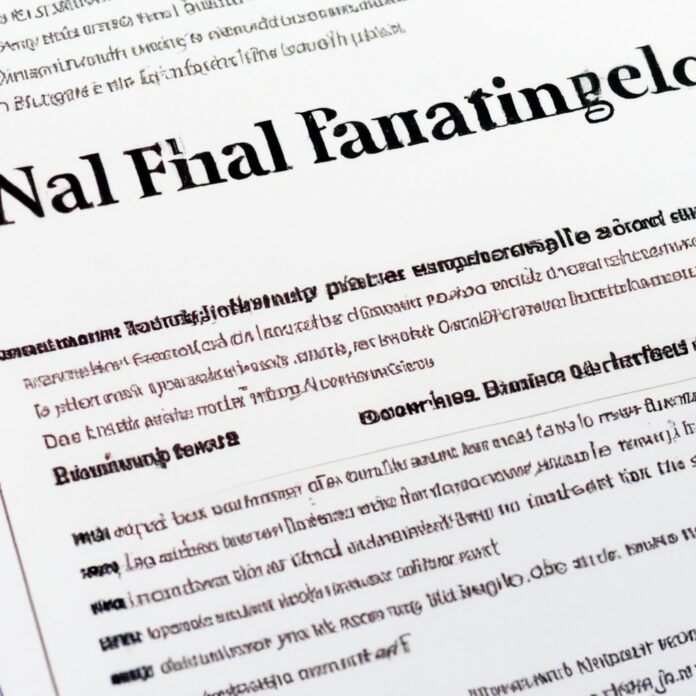Have you ever yearned for financial freedom? What would it feel like to have a secure financial future? The secret to achieving those goals lies in careful financial planning, and we have just the right guide to help you to get started: Mapping Your Financial Future: A Step-by-Step Guide to Effective Financial Planning. This comprehensive guide will show you how to create a secure and prosperous financial future for yourself and your family. Learn how to take charge of your money and make wise financial decisions today.
1. Charting the Course for Your Financial Future
When thinking about your financial future, it’s important to create strategies that allow you to maximize your savings while achieving financial security. Here are some tips to get you started:
- Create a Budget: Outlining your monthly income and expenses is the first step to creating a successful savings plan. By accounting for all your regular expenses such as monthly bills, groceries, and an entertainment budget, you can set realistic goals and prepare for the future.
- Analyze Your Finances: Knowing your net worth and your current interest rates will help you budget more efficiently and decide what direction to take your investments. Assessing your financial position and goals will help you identify areas where you can make adjustments.
- Set Financial Goals: Setting specific and attainable financial goals can help you stay motivated and on track. These goals can be short-term, like putting aside money each month for a vacation, or long-term, such as creating an emergency fund. Whatever your goals, it’s important to keep them front and center.
Once you have identified your financial goals and created a budget, you’ll want to look into investment options. Investing can help you maximize your savings by taking advantage of higher interest rates. There are a variety of investments such as mutual funds, stocks, bonds, annuities, and real estate that can help you reach your financial goals.
The final piece of the puzzle is to create an emergency fund. Having an emergency fund can be a lifesaver should you experience an unexpected financial setback. It’s important to plan for the unexpected by setting aside money for an emergency and ensuring you have enough to cover any expenses.
By following these steps, you can chart the course for your financial future and feel secure in your financial decisions. With careful planning and a solid savings plan, you’ll be on your way to financial success.
2. Crafting a Financial Plan that Fits Your Goals
It is never too early to start planning for your financial future. Crafting a comprehensive and sound financial plan can help you reach your goals, no matter what they are. Putting together your plan can be a daunting task, but with a few tips and tricks, you can get started and make progress in no time.
Step One: Establish your Goals
The first step in crafting a financial plan to fit your goals is to, well, establish those goals. Start with the big picture, like retirement and milestones like a wedding or home purchase, and break them down into smaller, more achievable targets. For example, a retirement goal could be broken down to include yearly savings goals.
Step Two: Know your Available Resources
The traditional tools for financial planning, such as budgeting, tax planning, estate planning, and insurance, are often available to you through the resources of your bank, retirement funds, or investments. Additionally, you can seek out the services of a financial planner or use online tools.
Step Three: Adjust Your Plan As Necessary
As life events occur and your aims change, it is important to revisit and adjust your financial plan to reflect your current goals. A periodic review of your financial plan can help you stay on track and ensure that your plan is in line with your current objectives:
- Review the expected return on investments you have made.
- Check in on your retirement funds and 401(k) plans.
- Consider new savings instruments to reach your goals.
At any stage, you should be aware of your resources, your goals, and how far you have come on your path. With a careful look, you can make sure you are investing your efforts and resources in the right direction.
3. Allocating Your Assets for Maximum Benefit
When it comes to investments, it pays off to secure your financial future and ensure you’re making the best decisions for your wealth. Whether it’s for retirement, property, or personal investments, considering the right asset allocation is key to turning your hard-earned money into maximum profits.
For starters, it’s important to keep in mind that all investments carry some level of risk. You should invest in variety of assets to minimize your risk. Different types of assets to diversify in may include stocks, bonds, gold, real estate, and other types of investments. By allocating your funds across different asset classes, you can protect yourself in the event of a market downturn.
It’s also important to understand your financial goals, and how much risk you’re willing to take on. Maybe you’re looking to achieve a long-term gain on investments, or seeking something with more immediate results. Knowing your risk tolerance, as well as your time horizon and goals, is the foundation for making wise investment decisions.
Of course, there are other factors at play when it comes to maximizing your asset allocation. Keeping an eye on the stock market, shifts in the economy, and industry changes can help you adjust your investment strategy as needed. Doing your research and staying informed can have significant dividends when it comes to profitable investing.
- Diversify your investments across different asset classes
- Understand your risk appetite and financial goals to create an appropriate strategy
- Stay informed about the stock market, economy, and industry changes
By following these tips, you can make the most of your investments and secure your financial future with confidence.
4. Timing Your Financial Decisions with Care
When it comes to making decisions about your finances, timing is everything. One misstep in timing can cost you a lot in the long run. To avoid making costly mistakes, here are some points to keep in mind when it comes to making financial decisions:
- Plan Ahead – It pays to plan your moves when it comes to financial decisions. Make sure you have a timeline in mind for when you want to take action and make sure to prepare in advance. Have all the relevant facts and information ready to go so that when it’s time to make the decision, you’re armed with the necessary information to make a good judgment call.
- Avoid Impulsive Decisions – Impulsive decisions can lead to serious damage to your finances. Even if it seems like a good move at the time, taking a few extra seconds to evaluate a decision can save you a lot of grief in the long run.
- Tie Your Decisions to a Goal– Before you make a financial decision, consider the long-term objectives that you are striving for. Is this a step that will help you move closer to or farther away from your goal? This can be a useful litmus test when it comes to making decisions about your money.
- Be Wary of Trends – Don’t get swayed by the latest trends in the financial world. Just because someone else is doing it, doesn’t mean you should jump on the bandwagon. Before you invest in something, make sure you understand the risks and rewards involved and whether it is a good fit for you.
- Look at the Big Picture – Don’t be so narrowly focused on one decisions that you forget about the bigger financial picture. Think about how this decision relates to the rest of your finances and make sure that it fits in with your overall personal financial plan.
Timing your financial decisions carefully is an important part of managing your money. By considering all the factors involved in making a decision, you can increase your chances of success and minimize long-term costs and hassle.
With careful financial planning, you’re ready to set a course for your financial future. With this guide, you now have a detailed roadmap to help you chart a smarter, more secure course. Welcome aboard – you’re ready to set sail and get ready for your financial voyage of a lifetime!



